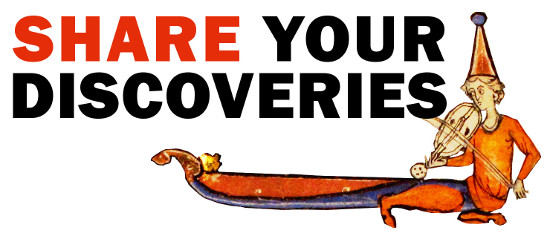Unusual pictures from the Manuscripts Department as it launches Image of the Month
Today the Manuscripts Department launches its Image of the Month project. The Image of the Month will feature single images of interesting objects or information from the Manuscripts and Archives collection. The project launches as part of the Explore Your Archive campaign, which seeks to raise awareness of the value and wonder of archives across the country.
Researchers and Manuscripts staff who work with the archives regularly come across unusual items, such as the grotesque in the image above. We’re keen to make these images of these items accessible to a wider audience, to surprise people with new discoveries of the kinds of things we hold, and to inspire them to find out more. Readers who use the Manuscripts Reading Room are invited to share interesting images or objects they find, and to contribute text, should they so desire. To contribute something you’ve found in the Manuscripts Reading Room to Image of the Month, please speak to a member of staff or contact us.
The name ‘Manuscripts Department’ probably makes most people think of hand-written medieval parchment books with illustrations of a religious nature. While we certainly have a large and important collection of medieval manuscripts at the University Library, we hold many other important collections dating from 3rd and 4th centuries right up to the present day, covering a wide range of subjects and in many different formats.
We hold significant collections of the papers of scientists such as Isaac Newton, Charles Darwin and Ernest Rutherford, collections by literary figures such as Siegfried Sassoon and Rudyard Kipling, and those of politicians such as Sir Robert Walpole and Stanley Baldwin. The records of the Ely diocese, which are important for family historians, are also held in Manuscripts. We have significant photograph collections, especially in the Royal Commonwealth Society collections, which have fantastic images of Commonwealth countries stretching right back to the middle of the 19th century.
We also have material relating to people and institutions less known but no less interesting. For example, we hold a collection from the Society for Psychical Research, which includes a ‘Luminous Trumpet’, an instrument purportedly used to help mediums communicate with spirits of the dead. We also are the only institution to hold a sample of an alleged ectoplasm!
Our collection also includes a letter from Captain Bligh of Mutiny on the Bounty fame, stating how he lost an experimental time-keeping machine to piracy. We also have a map of the Charge of the Light Brigade, sketched by Lord Cardigan at the request of one of his fellow diners, a young lady probably who he wanted to impress after he’d had a few glasses of wine. We hold a manuscript from Kashmir with pages made of birch bark written about 600 years ago, and a tremendous collection of beautiful Sanskrit manuscripts, many of which are being catalogued for the first time by the Sanskrit Manuscripts Project.
The Explore Your Archive campaign was launched by the Archives and Records Association and The National Archives to raise awareness of archives, their value to society and the impact they have every day on individual lives. Explore Your Archive seeks to help people understand that the material in archives provides a key to how we have become the people we are today and how the world in which we live has developed. In line with Explore Your Archive week, Image of the Month is designed to whet the interest of those who are yet archive users, as well as engaging those who are.
Events and initiatives are taking place in archives all round the country from 16-22 November. Institutions such as the Victoria and Albert Museum, the Natural History Museum, and the National Archives all have events going on. More locally Huntingdon Library and Archive has a display of photographs from The Whitney Collection of Huntingdonshire places, buildings, events and people from the 1860s to the 1920s. The Manuscripts Department is proud to stand alongside archives throughout the country, all of which preserve vital histories.

